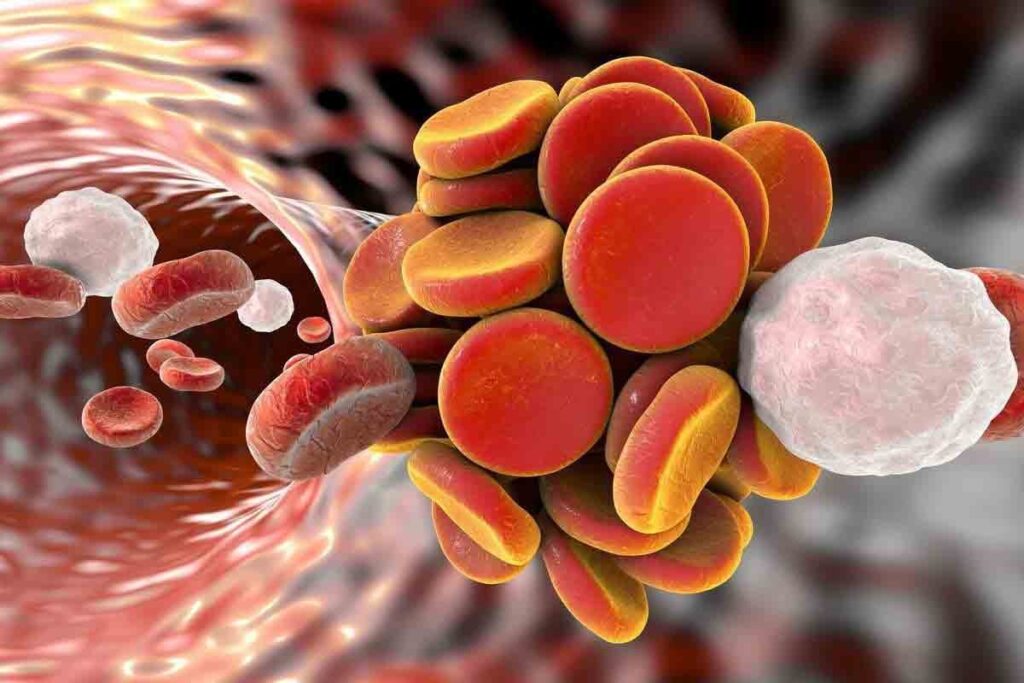
A pulmonary embolism is a serious condition caused by a blockage in the lung artery. It usually comes from deep vein thrombosis (DVT). Understanding its symptoms and duration is key for timely medical help.
Symptoms of a blood clot in the lung can appear suddenly or slowly. They include shortness of breath, sharp chest pain, cough, fainting, dizziness, and leg swelling. At LivHospital, we focus on patient safety and advanced care to manage blood clots well.
It’s important to recognize these symptoms quickly. This is because a pulmonary embolism can be deadly if not treated right away.

Pulmonary embolism is a blockage in a lung artery by a blood clot. It’s a serious and potentially deadly condition that needs quick medical help.
A pulmonary embolism happens when a blood clot in the legs breaks loose. It then travels to a lung artery, blocking blood flow. This blockage can cause tissue damage and can be fatal if not treated quickly.
Deep vein thrombosis (DVT) and pulmonary embolism are closely related. DVT is the main cause of pulmonary embolism. Risk factors for DVT, like being immobile for a long time, cancer, and genetic clotting disorders, also raise the risk for pulmonary embolism. Knowing this link is key for prevention and early detection.
Pulmonary embolism can vary from mild to life-threatening. The severity depends on the clot size and the patient’s health.
| Severity Level | Characteristics | Symptoms |
| Minor | Small clot, minimal blockage | Mild shortness of breath, slight chest pain |
| Moderate | Noticeable blockage, some lung tissue affected | Shortness of breath, chest pain, cough |
| Severe | Large clot, significant blockage, potentially life-threatening | Severe shortness of breath, intense chest pain, fainting |
Understanding the severity of pulmonary embolism is vital for getting the right medical care.

Spotting blood clots in the lungs can be life-saving. Pulmonary embolism (PE) symptoms vary and can be tricky to spot. This makes quick diagnosis key.
Some people face sudden, severe symptoms that need quick medical help. These include:
Doctors stress the importance of quick action. “Prompt recognition of these symptoms is vital for timely intervention and preventing fatal outcomes.”
At times, PE symptoms develop slowly. This makes them less obvious. These signs include:
Knowing these slow signs is critical. They can signal a serious issue.
The size and location of the clot affect symptoms. Larger clots cause more severe symptoms. Smaller clots may lead to milder signs.
| Clot Size | Common Symptoms | Severity |
| Small | Mild shortness of breath, slight chest discomfort | Mild to Moderate |
| Medium | Noticeable shortness of breath, chest pain with deep breathing | Moderate to Severe |
| Large | Severe shortness of breath, intense chest pain, coughing up blood | Severe |
Knowing these differences helps both patients and doctors. It aids in recognizing PE signs and taking action.
Knowing how long a pulmonary embolism lasts is key for recovery. The time symptoms last can change a lot. It depends on many things.
At first, symptoms like chest pain and trouble breathing can last from days to weeks. These symptoms are usually the worst right after the event.
Acute Symptom Duration: With the right treatment, most symptoms get better in 1-2 weeks. But, how long it takes can change. It depends on the clot size and treatment success.
Even after acute symptoms go away, some people may feel symptoms for months. These can be mild, like shortness of breath or feeling tired.
“The recovery process can be lengthy, and it’s not uncommon for patients to experience lingering symptoms for several months after the initial event,” says a leading pulmonologist.
How long these symptoms last can change. It depends on the clot size, health, and any other health issues.
Many things can affect how long it takes to get better from a pulmonary embolism. These include:
| Factor | Influence on Recovery |
| Clot Size | Larger clots may prolong recovery |
| Treatment Effectiveness | Effective treatment can shorten recovery |
| Overall Health | Poor health can extend recovery time |
By knowing these factors and working with doctors, patients can handle the recovery better. They can also set realistic expectations about how long symptoms will last.
Pulmonary embolism symptoms can change or stay the same. This makes it hard to diagnose because symptoms might not always be there. They can also be mistaken for other health issues.
Some symptoms, like shortness of breath or chest pain, can change. This happens because the blood clot moves or the body reacts differently. It’s important to remember that even if symptoms seem better, you might need to see a doctor right away.
Some symptoms are very serious and need immediate attention. These include sudden shortness of breath, chest pain that gets worse with deep breaths, and coughing up blood. If you see these, get to the hospital fast.
Symptoms of pulmonary embolism can look like other serious problems, like heart attacks or pneumonia. To tell them apart, doctors use tests like CT scans or blood tests. Knowing the differences is key to getting the right treatment.
It’s vital to know the warning signs and get help quickly if you have symptoms. Getting a correct diagnosis fast is important for treating pulmonary embolism well.
Pulmonary embolism can sneak up on you, often without you even realizing it. It happens when a blood clot blocks a lung artery. This can be very dangerous because it might not show any symptoms at first.
We’ll look into how silent pulmonary embolism works, who’s at risk, and how it’s found. Knowing this can help catch it early and treat it right.
Silent pulmonary embolism means you have a clot in your lung but don’t feel any symptoms. This is scary because it can lead to a late diagnosis. Research shows many cases of pulmonary embolism don’t show symptoms, making it critical to stay alert.
“The absence of symptoms does not necessarily mean the absence of a pulmonary embolism,” doctors say. This shows why knowing your risk factors and taking care of your health is so important.
Some things make you more likely to have a silent pulmonary embolism. These include:
Knowing these risk factors helps both you and your doctor watch out for it. This might lead to catching it sooner.
When a pulmonary embolism is found, it’s usually during a check-up for something else or when symptoms show up. Tests like CT scans are key in spotting PE. Sometimes, a clot is found by accident while checking for other health issues.
It’s vital to get checked out if you’re at risk, even if you don’t feel sick. Early detection is the best way to treat it effectively.
When a pulmonary embolism is suspected, doctors use many tools to confirm it. Accurate and quick diagnosis is key for good treatment and patient care. We will explain how doctors diagnose and manage pulmonary embolism.
Several tests are used to diagnose pulmonary embolism. The D-dimer test is first to check for blood clots. But, for a sure diagnosis, CT pulmonary angiography (CTPA) is used. CTPA shows detailed images of the lungs’ blood vessels, helping doctors spot clots.
The time to get a diagnosis can vary a lot. Some people get diagnosed quickly, while others face delays. This can happen due to unclear symptoms or the need for more tests.
In emergency settings, the first goal is to keep the patient stable and stop more clotting. Anticoagulant medications are given quickly to stop clots from growing. In very serious cases, thrombolysis might be considered.
Pulmonary embolism treatment includes various strategies, each affecting recovery time differently. The treatment choice depends on the embolism’s severity, the patient’s health, and any underlying conditions.
Anticoagulation therapy is key for most pulmonary embolism patients. It prevents new blood clots and stops existing ones from growing. Treatment usually lasts at least three months, but can extend based on risk factors.
Key aspects of anticoagulation therapy include:
We teach our patients about the importance of sticking to their anticoagulation regimen. We also discuss the risks and benefits of these medications.
For severe pulmonary embolism, more aggressive treatments are used. These include thrombolysis to dissolve clots and surgical embolectomy in some cases.
“Thrombolysis is considered for patients with hemodynamically unstable pulmonary embolism, as it can rapidly restore blood flow to the lungs.” –
American Heart Association Guidelines
These advanced treatments are for patients at high risk of complications or death from their pulmonary embolism.
Hospital stay for pulmonary embolism varies by condition severity and treatment response. Patients with uncomplicated cases might be discharged in a few days.
Factors influencing hospitalization length include:
We help patients and their families smoothly transition to home care. We educate them on managing medications, follow-up appointments, and watching for complications.
It’s important to know what causes clots in the lungs. Pulmonary embolism (PE) is a serious condition. It can happen due to genetics, environment, and health issues.
There are several risk factors for pulmonary embolism. These include:
Some medical conditions increase the risk of pulmonary embolism. These include:
Genetics play a big role in clotting disorders that can lead to pulmonary embolism. Some of these include:
Knowing these risk factors and genetic predispositions can help people take steps to lower their risk of pulmonary embolism.
It’s important to know about the long-term effects of pulmonary embolism. Both patients and doctors need to understand this. Recovery from a pulmonary embolism can take a long time. Some people may have lasting effects or new problems.
Some people get post-PE syndrome. This means they have ongoing symptoms like shortness of breath and tiredness. These symptoms can last for months or years, making life harder.
Managing post-PE syndrome involves breathing exercises, physical therapy, and lifestyle changes. These help improve health and lessen symptoms.
Chronic thromboembolic pulmonary hypertension (CTEPH) is a serious complication. It happens when blood clots in the lungs cause high blood pressure in the pulmonary arteries. This puts strain on the right side of the heart.
The mental effects of a pulmonary embolism are significant. Many survivors deal with anxiety, depression, and PTSD. The fear of another clot and managing medication can really affect their life.
It’s key to have support from mental health professionals, support groups, and family. They help cope with these challenges.
Regular check-ups are important for managing long-term effects. A typical follow-up plan includes:
| Time Frame | Follow-up Activities |
| 1-3 months post-PE | Check on anticoagulant therapy, watch for signs of post-PE syndrome |
| 6-12 months post-PE | Look for CTEPH, adjust treatment plans if needed |
Knowing about long-term effects and following a care plan helps patients recover better. It improves their quality of life.
Recovering from a pulmonary embolism needs a full plan. This includes medical care, lifestyle changes, and ongoing support. With the right treatment and help, many people can get better and live active lives.
It’s key to manage pulmonary embolism symptoms well for recovery. We help patients create care plans that fit their needs. This helps them stay healthy in the long run.
For those living with pulmonary embolism, being aware of the condition is important. It means following medication, making healthy choices, and going to check-ups. This helps track progress and stay on the right path.
Understanding and managing PE symptoms is vital. Knowing about the condition and its treatments helps people on their recovery path. This way, they can reach the best possible results.
We aim to offer top-notch healthcare and support for international patients. Our team is here to help people recover from pulmonary embolism. We want to improve their quality of life.
Symptoms of pulmonary embolism can last from a few days to several weeks or even months. This depends on the clot size, treatment success, and your health.
Yes, symptoms can change, making it hard to diagnose. If symptoms come back or get worse, get medical help right away.
You might have a pulmonary embolism without symptoms, known as silent pulmonary embolism. It can be found during tests for other issues or when symptoms show up.
Look out for sudden shortness of breath, chest pain that gets worse with deep breathing, coughing up blood, and severe leg pain or swelling. If you see these signs, get medical help fast.
Doctors use tests like D-dimer, CT pulmonary angiography (CTPA), and sometimes ventilation-perfusion scans or ultrasound. The test choice depends on your symptoms and risk factors.
Treatment includes anticoagulation therapy to stop more clots and dissolve the existing one. Treatment time varies but often lasts months to a year or more, based on your risk and health.
Blood clots in the lungs often start as deep vein thrombosis (DVT) in the legs. Other causes include being immobile, surgery, certain health conditions, and genetic factors.
Yes, long-term issues include post-PE syndrome, chronic thromboembolic pulmonary hypertension (CTEPH), and mental health problems like anxiety or depression. It’s important to follow up with care to manage these risks.
A correct diagnosis needs a detailed medical check, including your history, physical exam, and tests. Conditions like pneumonia, asthma, or heart attack can seem similar, so getting a proper diagnosis is key.
Recovery times vary based on the embolism’s severity, treatment success, and your health. Symptoms usually improve in days to weeks, but getting back to normal can take longer.
PE is a blockage caused by a clot in lung arteries, commonly from DVT. Symptoms include sharp chest pain, shortness of breath, fainting, and leg swelling. Immediate medical attention is critical.https://medlineplus.gov/pulmonaryembolism.html
Subscribe to our e-newsletter to stay informed about the latest innovations in the world of health and exclusive offers!
WhatsApp us